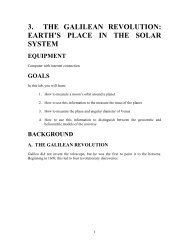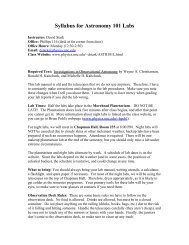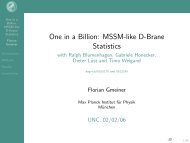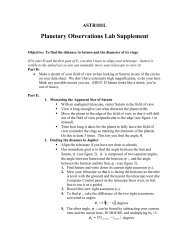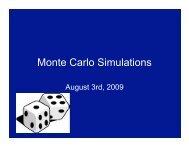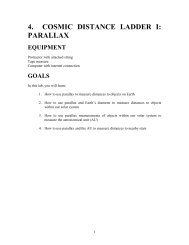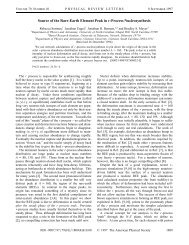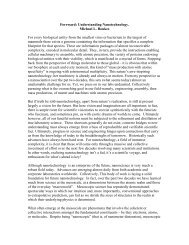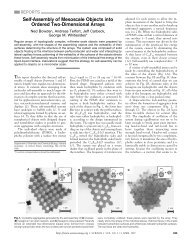holographic principle and the surface of last scatter
holographic principle and the surface of last scatter
holographic principle and the surface of last scatter
You also want an ePaper? Increase the reach of your titles
YUMPU automatically turns print PDFs into web optimized ePapers that Google loves.
Thank you for <strong>the</strong> invitation.<br />
HOLOGRAPHIC PRINCIPLE AND<br />
THE SURFACE OF<br />
LAST SCATTER<br />
Paul H. Frampton
OUTLINE<br />
Accelerating Expansion<br />
Dark Energy Problem<br />
Emergent Gravity<br />
Holographic Principle<br />
Observable Universe<br />
2
References<br />
PHF<br />
Solution to <strong>the</strong> Dark Energy Problem<br />
arXiv:1004.1285<br />
PHF<br />
Possible Solution <strong>of</strong> Dark Matter, The Solution<br />
<strong>of</strong> Dark Energy, <strong>and</strong> Gell-Mann as<br />
Great Theoretician<br />
arXiv:1004.1910 [hep-ph].<br />
D.A. Easson, PHF <strong>and</strong> G.F. Smoot<br />
Entropic Accelerating Universe<br />
arXiv:1002.4278 [hep-th]<br />
Entropic Inflation<br />
arXiv:1003.1528<br />
3
Accelerating expansion<br />
In fundamental <strong>the</strong>oretical physics, <strong>the</strong>re was,<br />
at <strong>the</strong> beginning <strong>of</strong> <strong>the</strong> twenty-first century, an<br />
impossibleseemingproblemwhichmightnotbe<br />
solved for a hundred years. The problem was<br />
<strong>the</strong> dark energy in cosmology, comprising some<br />
seventy percent <strong>of</strong> <strong>the</strong> universe.<br />
Ano<strong>the</strong>rcosmologicalproblem,closelyentwined<br />
with <strong>the</strong> dark energy problem, is <strong>the</strong> question<br />
well posed, now almost eight decades ago, by<br />
Tolman whe<strong>the</strong>r one can construct a consistent<br />
cyclic model, given <strong>the</strong> seemingly contradictory<br />
constraint imposed by <strong>the</strong> second law <strong>of</strong> <strong>the</strong>rmodynamics.<br />
The most developed solution, <strong>of</strong><br />
this Tolman conundrum, is that suggested by<br />
Baum <strong>and</strong> myself in Phys. Rev. Lett. 2007.<br />
4
The most important observational advance in<br />
cosmology, since <strong>the</strong> early studies <strong>of</strong> cosmic expansion<br />
in <strong>the</strong> 1920’s ,was <strong>the</strong> dramatic <strong>and</strong>,<br />
at that time, surprising discovery, in <strong>the</strong> waning<br />
years <strong>of</strong> <strong>the</strong> twentieth century, that <strong>the</strong> expansion<br />
rate is accelerating. This was first announcedinFebruary1998,<br />
basedon<strong>the</strong>concordance<br />
<strong>of</strong> two groups’ data.<br />
Many subsequent experiments concerning <strong>the</strong><br />
Cosmic Microwave Background (CMB), Large<br />
Scale Structure (LSS), <strong>and</strong> o<strong>the</strong>r measurements<br />
have all confirmed <strong>the</strong> 1998 claim. We may<br />
<strong>the</strong>refore adopt <strong>the</strong> position, that <strong>the</strong> accelerated<br />
expansion rate is an observed fact.<br />
5
Assuming general relativity, toge<strong>the</strong>r with<br />
<strong>the</strong> cosmological <strong>principle</strong> <strong>of</strong> homogeneity <strong>and</strong><br />
isotropy, <strong>the</strong> scale factor a(t) in <strong>the</strong> FRW metric<br />
satisfies <strong>the</strong> Friedmann-Lemaître equation<br />
H(t) 2 =<br />
⎛<br />
⎜<br />
⎝<br />
ȧ<br />
a<br />
⎞<br />
⎟<br />
⎠<br />
2<br />
=<br />
⎛<br />
⎜<br />
⎝<br />
8πG<br />
3<br />
⎞<br />
⎟<br />
⎠ρ (1)<br />
whereIshallnormalizea(t 0 ) = 1at<strong>the</strong>present,<br />
time t = t 0 , <strong>and</strong> ρ is an energy density source<br />
which drives <strong>the</strong> expansion <strong>of</strong> <strong>the</strong> universe.<br />
6
Two established contributions to ρ are ρ m from<br />
matter (including dark matter) <strong>and</strong> ρ γ radiation,<br />
so that<br />
ρ ⊇ ρ m +ρ γ (2)<br />
with ρ m (t) = ρ m (t 0 )a(t) −3 <strong>and</strong> ρ γ (t) =<br />
ρ γ (t 0 )a(t) −4 .<br />
7
For <strong>the</strong> observed accelerated expansion, <strong>the</strong><br />
most popular approach is to add to <strong>the</strong> sources,<br />
in Eq.(1), a dark energy term ρ DE (t) with<br />
ρ DE (t) = ρ DE (t 0 )a(t) −3(1+ω) (3)<br />
where ω = p/ρ is <strong>the</strong> equation <strong>of</strong> state. For<br />
<strong>the</strong> case ω = −1, as for a cosmological constant,<br />
Λ, <strong>and</strong> discarding <strong>the</strong> matter <strong>and</strong> radiation<br />
terms which are smaller I can easily integrate<br />
<strong>the</strong> Friedmann-Lemaître equation to find<br />
a(t) = a(t 0 ) e Ht (4)<br />
where √ 3H = √ Λ = √ 8πGρ DE .<br />
8
By differentiation with respect to time p times,<br />
we obtain for <strong>the</strong> p th derivative<br />
d p<br />
dt pa(t)| t=0 = ( √ Λ/3) p (5)<br />
Therefore, if Λ > 0 is positive, as in a De Sitter<br />
geometry, not only is <strong>the</strong> acceleration (p = 2)<br />
positive <strong>and</strong> non-zero, but so are <strong>the</strong> jerk (p =<br />
3), <strong>the</strong> snap (p = 4), <strong>the</strong> crackle (p = 5), <strong>the</strong><br />
pop (p = 6) <strong>and</strong> all p ≥ 7.<br />
The insertion <strong>of</strong> <strong>the</strong> dark energy term works<br />
very well as a part <strong>of</strong> <strong>the</strong> ΛCDM model. However,<br />
it is an ad hoc procedure which gives no<br />
insight into what dark energy is.<br />
9
Dark Energy Problem<br />
With this background, I shall now move to my<br />
different explanation for <strong>the</strong> accelerated expansion<br />
which obviates any dark energy, including<br />
any need for a cosmological constant.<br />
I now adopt a different approach, with no dark<br />
energy, where instead <strong>the</strong> central role is played<br />
by <strong>the</strong> assumption <strong>of</strong> <strong>the</strong> <strong>holographic</strong> <strong>principle</strong>,<br />
<strong>and</strong> by <strong>the</strong> overiding concept <strong>of</strong> entropy.<br />
10
The essential assumption is <strong>the</strong> aforementioned<br />
<strong>holographic</strong> <strong>principle</strong>, by which I underst<strong>and</strong><br />
thatall<strong>the</strong>informationabout<strong>the</strong>universeisencodedonitstwo-dimensional<strong>surface</strong>.<br />
Whatthis<br />
implies is, however unlikely it seems <strong>and</strong> however<br />
contrary to everyday experience, that <strong>the</strong><br />
three-dimensionalworldIapparentlyobserve,is<br />
somehow an illusion. This can lead to a reinterpretation<br />
<strong>of</strong> <strong>the</strong> cosmic acceleration, <strong>and</strong> possibly<br />
<strong>the</strong> most dramatic new insight into gravity<br />
in over three centuries.<br />
11
Consider <strong>the</strong> Schwarzschild radius (r s ), <strong>and</strong> <strong>the</strong><br />
physical radius (r), <strong>of</strong> <strong>the</strong> Sun (⊙). They are<br />
(r s ) ⊙ = 3km <strong>and</strong> r ⊙ = 800,000km. Their<br />
ratio is (ǫ) ⊙ ≡ (r s /r) ⊙ = 3 × 10 −6 . One<br />
can readily check that, for <strong>the</strong> Earth or for <strong>the</strong><br />
Milky Way, that <strong>the</strong> ratio ǫ = (r s /r) is likewise<br />
much smaller than one: ǫ
At this horizon, <strong>the</strong>re is PBH temperature, T β ,<br />
which I can estimate as<br />
T β = ¯h<br />
k B<br />
H<br />
2π ∼ 3×10−30 K. (6)<br />
This temperature <strong>of</strong> <strong>the</strong> horizon information<br />
screen leads to a concomitant FDU acceleration<br />
a Horizon , outward, <strong>of</strong> <strong>the</strong> horizon given by <strong>the</strong><br />
relationship<br />
a Horizon =<br />
⎛<br />
⎜<br />
⎝<br />
2πck B T β<br />
¯h<br />
⎞<br />
⎟<br />
⎠ = cH ∼ 10 −9 m/s 2 .<br />
(7)<br />
When T β is used in Eq. (7), I arrive at a cosmic<br />
acceleration which is essentially in agreement<br />
with <strong>the</strong> observations.<br />
13
From this viewpoint, <strong>the</strong> dark energy is nonexistent.<br />
Instead <strong>the</strong>re is a consequence <strong>of</strong> <strong>the</strong><br />
second law <strong>of</strong> <strong>the</strong>rmodynamics, acting to create<br />
<strong>the</strong> appearance <strong>of</strong> a dark energy component <strong>of</strong><br />
<strong>the</strong>drivingdensityon<strong>the</strong>right-h<strong>and</strong>-side<strong>of</strong><strong>the</strong><br />
Friedman-Lemaître equation, Eq.(1).<br />
Ihavediscusseda<strong>the</strong>oryunderlying<strong>the</strong>acceleratedexpansion<strong>of</strong><strong>the</strong>universebasedonentropy.<br />
This approach provides a physical underst<strong>and</strong>ing<br />
<strong>of</strong> <strong>the</strong> acceleration phenomenon which was<br />
lacking in <strong>the</strong> description as dark energy.<br />
14
The entropy <strong>of</strong> <strong>the</strong> universe has received some<br />
recent attention, in part because it relates to<br />
<strong>the</strong> feasibility <strong>of</strong> constructing a consistent cyclic<br />
model. For example, <strong>the</strong> cyclic model, assuming<br />
its internal consistency will indeed be fully<br />
confirmed, provides <strong>the</strong> solution to a difficult<br />
entropy question originally posed, seventy-five<br />
years earlier, by Tolman. The accelerated expansion<br />
rate is no longer surprising. It is <strong>the</strong> inevitable<br />
consequence <strong>of</strong> information storage on<br />
<strong>the</strong> <strong>surface</strong> <strong>of</strong> <strong>the</strong> visible universe.<br />
15
Emergent Gravity<br />
This solution <strong>of</strong> <strong>the</strong> dark energy problem not<br />
only solves a cosmological problem, it casts a<br />
completely new light on <strong>the</strong> nature <strong>of</strong> <strong>the</strong> gravitational<br />
force. Since <strong>the</strong> expansion <strong>of</strong> <strong>the</strong> universe,<br />
including <strong>the</strong> acceleration <strong>the</strong>re<strong>of</strong>, can<br />
only be a gravitational phenomenon, I arrive at<br />
<strong>the</strong> viewpoint that gravity is a classical result <strong>of</strong><br />
<strong>the</strong> second law <strong>of</strong> <strong>the</strong>rmodynamics. This means<br />
that gravity cannotbe regarded as, on a footing<br />
with, <strong>the</strong> electroweak <strong>and</strong> strong interactions.<br />
Although this can be <strong>the</strong> most radical change,<br />
in gravity <strong>the</strong>ory, for over three centuries, it is<br />
worth emphasizing that general relativity, <strong>and</strong><br />
itsclassicaltests, remainunsca<strong>the</strong>d, asdoes<strong>the</strong><br />
prediction <strong>of</strong> gravitational waves.<br />
16
My result calls into question almost all <strong>of</strong> <strong>the</strong><br />
workdoneonquantumgravity,since<strong>the</strong>discovery<br />
<strong>of</strong> quantum mechanics. For gravity, <strong>the</strong>re<br />
is no longer necessity for a graviton. In <strong>the</strong><br />
case <strong>of</strong> string <strong>the</strong>ory, <strong>the</strong> principal motivation<br />
for <strong>the</strong> pr<strong>of</strong>ound <strong>and</strong> historical suggestion by<br />
Scherk <strong>and</strong> Schwarz that string <strong>the</strong>ory be reinterpreted,<br />
not as a <strong>the</strong>ory <strong>of</strong> <strong>the</strong> strong interaction,butinsteadasa<strong>the</strong>ory<strong>of</strong><strong>the</strong>gravitational<br />
interaction, came from <strong>the</strong> natural appearance<br />
<strong>of</strong>amasslessgravitonin<strong>the</strong>closedstringsector.<br />
I am not saying that string <strong>the</strong>ory is dead.<br />
What I am saying is, that string <strong>the</strong>ory cannotbea<strong>the</strong>ory<strong>of</strong><strong>the</strong>fundamentalgravitational<br />
interaction, since <strong>the</strong>re is no fundamental gravitational<br />
interaction.<br />
17
Thewaythisnewinsightemerged,<strong>and</strong><strong>the</strong>solution<br />
<strong>of</strong> <strong>the</strong> dark energy problem itself, was as a<br />
natural line <strong>of</strong> thought, following <strong>the</strong> discovery<br />
<strong>of</strong> a cyclic model <strong>and</strong> <strong>the</strong> subsequent investigations<br />
<strong>of</strong> <strong>the</strong> entropy <strong>of</strong> <strong>the</strong> universe, including a<br />
possible c<strong>and</strong>idate for dark matter.<br />
18
Ano<strong>the</strong>rramification,<strong>of</strong>mysolution<strong>of</strong><strong>the</strong>dark<br />
energy, problem is <strong>the</strong> status, fundamental versus<br />
emergent, <strong>of</strong> <strong>the</strong> three spatial dimensions,<br />
that we all observe every day. Because <strong>the</strong> solution<br />
assumes <strong>the</strong> <strong>holographic</strong> <strong>principle</strong>, at least<br />
one spatial dimension appears as emergent. Regarding<br />
<strong>the</strong> visible universe as a sphere, with<br />
radius <strong>of</strong> about 48 Gly, <strong>the</strong> emergent space dimension<br />
is <strong>the</strong>n, in spherical polar coordinates,<br />
<strong>the</strong> radial coordinate, while <strong>the</strong> o<strong>the</strong>r two coordinates,<br />
<strong>the</strong> polar <strong>and</strong> azimuthal angles, remain<br />
fundamental. Physical intuition, related<br />
to <strong>the</strong> isotropy <strong>of</strong> space, may suggest that, if<br />
one space dimension is emergent, <strong>the</strong>n so must<br />
be all three. This merits fur<strong>the</strong>r investigation,<br />
<strong>and</strong> may require a generalization <strong>of</strong> <strong>the</strong> <strong>holographic</strong><br />
<strong>principle</strong>. On <strong>the</strong> o<strong>the</strong>r h<strong>and</strong>, a fundamental<br />
time coordinate is useful in dynamics.<br />
19
Of course, this present discussion <strong>of</strong> cosmic acceleration,<br />
is merely one small step towards <strong>the</strong><br />
ultimate goal, <strong>of</strong> a cyclic model, in which time<br />
never begins or ends.<br />
20
Once we accept that gravity is emergent, <strong>and</strong> a<br />
result <strong>of</strong> <strong>the</strong> 2nd law <strong>of</strong> <strong>the</strong>rmodynamics, <strong>the</strong>n<br />
in <strong>the</strong> law F = Gm 1 m 2 /r 2 at least one <strong>of</strong> <strong>the</strong><br />
systems 1 <strong>and</strong> 2 must be large, meaning that it<br />
hasatleaste 3 ∼ 20particles. Thegravitational<br />
force between two elementary particles e.g. two<br />
protons, is zero. So, at LHC, gravity is not only<br />
irrelevant, it is zero!<br />
21
Holographic <strong>principle</strong><br />
For <strong>the</strong> case <strong>of</strong> a sphere, with mass M, <strong>of</strong> radius<br />
R, where R will be <strong>the</strong> co-moving radius<br />
for <strong>the</strong> exp<strong>and</strong>ing universe, a simplified, <strong>and</strong><br />
non-covariant form, <strong>of</strong> <strong>the</strong> <strong>holographic</strong> <strong>principle</strong>,<br />
states that <strong>the</strong> entropy, S/k, has an upper<br />
limit equal to that <strong>of</strong> a black hole, i.e.<br />
⎛<br />
⎜<br />
⎝<br />
S<br />
k<br />
⎞<br />
⎟<br />
⎠ ≤<br />
⎛<br />
⎜<br />
⎝<br />
S<br />
k<br />
⎞<br />
⎟<br />
⎠ =<br />
BH<br />
⎛<br />
⎜<br />
⎝<br />
1<br />
4<br />
⎞<br />
⎟<br />
⎠<br />
⎛<br />
⎜<br />
⎝<br />
4πR 2 S<br />
l 2 Planck<br />
⎞<br />
⎟<br />
⎠<br />
(8)<br />
where G is Newton’s constant, R S = 2GM<br />
is <strong>the</strong> Schwarzschild radius <strong>and</strong> l Planck is <strong>the</strong><br />
Planck length. It is interesting, from <strong>the</strong><br />
viewpoint <strong>of</strong> <strong>the</strong> physical underst<strong>and</strong>ing <strong>of</strong> <strong>the</strong><br />
visible universe, to use accurate observational<br />
data to check, whe<strong>the</strong>r <strong>the</strong> simplied, <strong>and</strong> noncovariant,Eq.(8)issatisfiedat<strong>the</strong>presenttime,<br />
t = t 0 , <strong>and</strong> in <strong>the</strong> past, cognizant that, with<br />
dark energy, if R sufficiently increases, Eq.(8)<br />
will, in any case, eventually be violated.<br />
22
The <strong>holographic</strong> <strong>principle</strong> is supported, by<br />
string <strong>the</strong>ory. The AdS/CFT correspondence<br />
is an explicit realization <strong>of</strong> Eq.(8), <strong>and</strong> so, apart<br />
from <strong>the</strong> non-trivial subtlety that our universe<br />
isdS,notAdS,from<strong>the</strong>viewpoint<strong>of</strong>string<strong>the</strong>ory,<br />
<strong>the</strong>re is every reason to believe <strong>the</strong> covariant<br />
<strong>holographic</strong> <strong>principle</strong>, <strong>and</strong> to wish to check<br />
Eq.(8). It is related to recent considerations <strong>of</strong><br />
<strong>the</strong> entropy <strong>of</strong> <strong>the</strong> universe.<br />
However, physics is an empirical science, <strong>and</strong><br />
<strong>the</strong>refore <strong>the</strong> scientific method dictates that we<br />
should find a physical example, in which Eq.(8)<br />
can be calculated. The result, reported here, is<br />
that a detailed <strong>and</strong> accurate check <strong>of</strong> Eq.(8),<br />
as applied to <strong>the</strong> visible universe, fails, by a<br />
statistically-significant amount, although in <strong>the</strong><br />
past, a few billion years ago, it was satisfied.<br />
23
I should define, precisely, what is meant by <strong>the</strong><br />
visible universe. It is <strong>the</strong> sphere, centered for<br />
convenience at <strong>the</strong> Earth, <strong>and</strong> with a radius<br />
d A (Z ∗ ) = 14.0±0.1Gpc. The value <strong>of</strong> d A (Z ∗ )<br />
is <strong>the</strong> particle horizon corresponding to <strong>the</strong> recombination<br />
red shift Z ∗ = 1090 ± 1, i <strong>and</strong> is<br />
measured directly by WMAP7, without needing<br />
<strong>the</strong> details <strong>of</strong> <strong>the</strong> expansion history. Thus,<br />
”visible” means with respect to electromagnetic<br />
radiation.<br />
24
Observable Universe<br />
The motion is that <strong>the</strong> visible universe, so defined,<br />
is a physical object which should be subject<br />
to <strong>the</strong> <strong>holographic</strong> <strong>principle</strong>. It is an exp<strong>and</strong>ing,<br />
ra<strong>the</strong>r than a static, object, yet my<br />
underst<strong>and</strong>ing is that <strong>the</strong> <strong>principle</strong>, at least in<br />
itscovariantform, isstillexpectedtobevalid. I<br />
shalluse<strong>the</strong>notationemployedby<strong>the</strong>WMAP7<br />
paper, from which all observational data are<br />
taken.<br />
The present age, t 0 , <strong>of</strong> <strong>the</strong> universe is measured<br />
to be<br />
t 0 = 13.75±0.13Gy (9)<br />
25
Thecomovingradius,d A (Z ∗ ),<strong>of</strong><strong>the</strong>visibleuniverse,<br />
is, likewise, measured to one percent accuracy,<br />
as<br />
d A (Z ∗ ) ≡ (1+Z ∗ )D A (Z ∗ ) = c ∫ t 0<br />
t ∗ dt<br />
a(t)<br />
= 14.0±0.1Gpc (10)<br />
where it is noted that <strong>the</strong> measurement, <strong>of</strong><br />
d A (Z ∗ ), does not require knowledge, <strong>of</strong> <strong>the</strong> expansion<br />
history, a(t), for t ∗ ≤ t ≤ t 0 .<br />
26
The critical density, ρ c , is provided by <strong>the</strong> formula<br />
ρ c =<br />
⎛<br />
⎜<br />
⎝<br />
3H 2 0<br />
⎞<br />
⎟<br />
⎟ (11)<br />
⎠<br />
8πG<br />
whose value depends on H 0 , as does <strong>the</strong> total,<br />
baryonic plus dark, matter density, ρ m<br />
ρ m ≡ Ω m ρ c (12)<br />
Because<strong>the</strong>erroron<strong>the</strong>Hubbleparameter,H 0 ,<br />
is several per cent, it is best to avoid H 0 , in<br />
checking <strong>the</strong> <strong>holographic</strong> <strong>principle</strong>.<br />
27
The mass <strong>of</strong> <strong>the</strong> matter, M(Z*), contained in<br />
<strong>the</strong> visible universe, is<br />
M(Z ∗ ) = 4π 3 d A(Z ∗ ) 3 ρ m (13)<br />
<strong>and</strong> <strong>the</strong> Schwarzschild radius, R S (Z ∗ ), is given<br />
by<br />
R S (Z ∗ ) ≡ 2GM(Z ∗ ) (14)<br />
Collecting results enables <strong>the</strong> desired accurate<br />
check <strong>of</strong> <strong>the</strong> <strong>holographic</strong> <strong>principle</strong>. The mass is<br />
M(Z∗) = 5.5×10 23 M ⊙ .<br />
28
The <strong>holographic</strong> pronciple requires that<br />
⎡⎛<br />
⎢<br />
⎣<br />
⎞<br />
⎝S⎠ ⎛ k<br />
⎞ V.U.<br />
⎝S<br />
k<br />
⎤<br />
⎥<br />
⎠ ⎦<br />
BH<br />
≤ 1 (15)<br />
A shift parameter, R, was defined by Bond, Efstathiou<br />
<strong>and</strong> Tegmark (BET) as<br />
R =<br />
√<br />
Ωm H 2 0<br />
c<br />
(1+Z ∗ )D A (Z ∗ ) (16)<br />
which was, with greatprescience, introduced by<br />
BET, as a dimensionless quantity, to be measured,<br />
accurately, by CMB observations.<br />
29
This BET shift parameter, R, <strong>of</strong> Eq. (16), is<br />
given in WMAP7, as<br />
R = 1.725±0.018 (17)<br />
A little algebra shows that <strong>the</strong> BET shift parameter<br />
R provides <strong>the</strong> most accurate available<br />
check, <strong>of</strong> <strong>the</strong> <strong>holographic</strong> <strong>principle</strong>, by virtue <strong>of</strong><br />
<strong>the</strong> result<br />
⎡⎛<br />
⎢<br />
⎣<br />
⎞<br />
⎝S⎠ ⎛ k<br />
⎞ V.U.<br />
⎝S<br />
k<br />
⎤<br />
⎥<br />
⎠ ⎦<br />
BH<br />
≡ R 4 = 8.85±0.37 (18)<br />
showing a violation, by 21σ.<br />
30
To my knowledge, <strong>the</strong> visible universe is, at<br />
present, <strong>the</strong> only physical object, for which it is<br />
possible to calculate, <strong>and</strong> compare with experiment,<br />
or observation, <strong>the</strong> simplified <strong>holographic</strong><br />
<strong>principle</strong>.<br />
From Eq. (15), <strong>the</strong> radius d A (Z HP ) = (1 +<br />
Z HP )D A (Z HP ), at which <strong>the</strong> violation <strong>of</strong><br />
Eq.(8), begins, is d A (Z HP ) = 8.4 ± 0.1Gpc,<br />
at a time, comparable to when <strong>the</strong> cosmic decelerationends,<br />
<strong>and</strong>becomesacceleration. This<br />
is strongly supportive <strong>of</strong> <strong>the</strong> idea <strong>of</strong> an entropic<br />
accelerating universe.<br />
The original aim, <strong>of</strong> <strong>the</strong> present work, was to<br />
confirm, at t = t 0 , <strong>the</strong> inequality, Eq.(15). It<br />
was, <strong>the</strong>refore, surprising to learn that it is violated,<br />
with high statistical significance, <strong>and</strong> has<br />
been so, for five billion years.<br />
31
4 3 2 1 1 2<br />
5<br />
10<br />
15<br />
20<br />
Thank you for your attention.<br />
32



